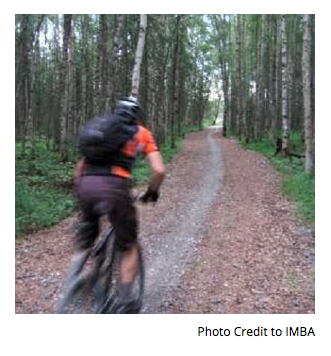
The biggest conflict between trail user types sharing the same trail is a difference in speed.
Runners and mountain bikers can often come into conflict with slower traveling hikers and walkers. Cyclists are generally moving much faster than someone who is walking or running.
Developing trails that provide an interesting and safe experience for all user groups can be challenging.
Recently, I received some complaints about a local trail which brought up the need to address this multi-faceted issue. I realize this could be one bad apple. In any segment of society, there is always going to be a small percentage behaving poorly that doesn’t represent the group as a whole.
Luckily, good trail design can help mitigate conflicts between users.
Trail DesignTrails built narrow and curvy can control speeds. Without good sight lines and a widely brushed corridor, cyclists will be unable to obtain high rates of speed. If the trail is wide with long sight lines it is easy to get going too fast.
The grade is also a factor in controlling the speed of trail users. If the grade is kept to about five percent or less it is more challenging to go fast. A five percent slope is five feet of elevation change for every 100 feet of trail. If the grade of the trail is eight to ten percent then it is easier for bikes to really get moving.
Chokes and collars can also be built along the trail to slow down cyclists. This is a physical barrier that forms a short, narrow section of trail and forces the cyclist to slow down. There can also be trails that are longer and further away from the trailhead which minimizes interaction between different user groups.
Another technique that can be used is to construct reverse grades throughout the trail route. By that I mean the downhill trail will reverse and become an uphill trail for 20 to 35 feet before returning to the downhill. This does two things: 1) it drains the trail, water that is following the trail downhill is forced off the trail and 2) at the same time, the uphill section of the trail moderates the speed.
Trail Etiquette
Kindness can go a long way.
Bikes move along fairly quietly and can startle people. If a hiker is elderly or has a hearing impairment, it can be especially hard to hear a bike coming.
Is it just me? When cyclists say, “On your left” I am always confused about which side of the trail to step to.
The responsibility is on the fastest user group. Be sure to slow down, say “hi” and smile. Making eye contact only takes a few seconds and has the power to totally change the feeling of the interaction.
I think it is dangerous to consider building one trail for bikes and one for pedestrians. This could set the stage for trail wars between user groups. Let’s continue to encourage users to share the trails and use them with consideration for everyone. Let’s be positive when we are out on the trail.
A New Ethic
Photo Credit to IMBABear Yuba Land Trust is excited to announce that we endorse “The Spirit of Howdy.” Truckee Donner Land Trust and the International Mountain Biking Association (IMBA) already promote this ethic.
“The Spirit of Howdy campaign represents the values that IMBA wishes to teach our youth. The Spirit of Howdy is more than being friendly to other trail users – it’s also about caring for the trails and our environment, stewarding our parks and natural resources, and giving back to our communities,” said IMBA’s Executive Director Mike van Abel said.
Begun in the late 1990s, NICA founder Matt Fritzinger, then a math teacher and coach, came up with the simple trail-use code for riders on his Berkeley High School team.
“Slow down enough so you can say ‘hello,’ AND they can say ‘hello’ back. Work to have a friendly interaction. Add to their day with kindness, don’t take away from it. The kids got it, and that became a league-wide rule in Northern California,” Fritzinger explained.
We hope that “The Spirit of Howdy” is endorsed and supported by all of our trail users and we can resolve conflicts in a good way. If you like what BYLT does, then become a member and support our organization. More members today = more trails tomorrow.
~ BYLT Trails Coordinator, Shaun Clarke
See the original post by Shaun HERE.
 RSS Feed
RSS Feed